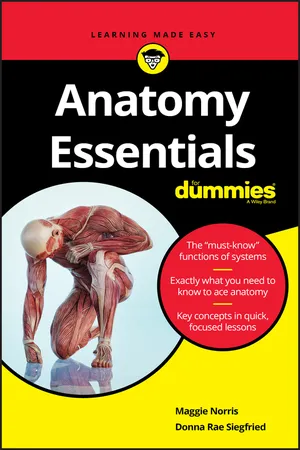
- English
- ePUB (mobile friendly)
- Available on iOS & Android
Anatomy Essentials For Dummies
About This Book
Anatomy Essentials For Dummies (9781119590156) was previously published as Anatomy Essentials For Dummies (9781118184219). While this version features a new Dummies cover and design, the content is the same as the prior release and should not be considered a new or updated product.
The core concepts you need to ace Anatomy
Perfect for those just starting out or returning to Anatomy after some time away, Anatomy Essentials For Dummies focuses on core concepts taught (and tested on!) in a typical Anatomy course. From names and technical terms to how the body works, you'll skip the suffering and score high marks at exam time with the help of Anatomy Essentials For Dummies.
Designed for students who want the key concepts and a few examples—without the review, ramp-up, and anecdotal content— Anatomy Essentials For Dummies is a perfect solution for exam-cramming, homework help, and reference.
- A useful and handy reference to the anatomy of the human body
- Perfect for a refresher or a quick reference
- Serves as an excellent review to score higher at exam time
If you have some knowledge of anatomy and want to polish your skills, Anatomy Essentials For Dummies focuses on just the core concepts you need to understand this fascinating topic.
Frequently asked questions
Information
Focusing on the Framework of Anatomy and Physiology





Looking at the Science of Anatomy and Physiology
Fitting anatomy and physiology into science
Breaking down the subsets of anatomy
- Gross anatomy: The study of the large parts of any animal body that can be seen with the unaided eye. (We concentrate on this aspect of anatomy in this book.)
- Histologic anatomy: The study of different tissue types and the cells that comprise them. Histologic anatomists use a variety of microscopes to study these cells and tissues that make up the body.
- Developmental anatomy: The study of the life cycle of the individual, from fertilized egg through adulthood, senescence (aging), and death. Body parts change throughout the life span.
- Comparative anatomy: The study of the similarities and differences among the anatomical structures of different species, including extinct species. This subject is closely related to evolutionary biology. Information from comparative anatomy helps scientists understand the human body’s structures and processes. For example, the comparative anatomy of humans and living and extinct apes elucidates the structures in the human limbs that enable the bipedal posture.
Familiarizing Yourself with Anatomical Jargon
Body System | Root or Word Fragment | Meaning |
Skeletal system | os-, oste- | bone |
arth- | joint | |
Muscular system | myo- | muscle |
sarco- | flesh | |
Integument | derm- | skin |
Nervous system | neur- | nerve |
Endocrine system | aden- | gland |
estr- | steroid | |
Circulatory system | card- | heart (muscle) |
angi- | vessel | |
hema- | blood | |
arter- | artery | |
ven- | venous | |
erythro- | red | |
Respiratory system | pulmon- | lung |
bronch- | windpipe | |
Digestive system | gastr- | stomach |
enter- | intestine | |
dent- | teeth | |
hepat- | liver | |
Urinary system | ren- | kidney |
neph- | kidney | |
ur- | urinary | |
Immune system | lymph- | lymph |
leuk- | white | |
Table of contents
- Cover
- Table of Contents
- Introduction
- Chapter 1: Focusing on the Framework of Anatomy and Physiology
- Chapter 2: Examining Cell Biology Basics
- Chapter 3: Scoping Out the Body’s Structural Layers
- Chapter 4: Getting to the Heart of the Circulatory System
- Chapter 5: Taking a Deep Breath with the Respiratory System
- Chapter 6: Getting on Track with the Digestive System
- Chapter 7: Passing through the Urinary System
- Chapter 8: Making Babies: The Reproductive System
- Chapter 9: Exploring the Nervous, Endocrine, and Immune Systems
- Chapter 10: Ten Phabulous Physiology Phacts
- Index
- About the Authors
- Advertisement Page
- Connect with Dummies
- End User License Agreement
